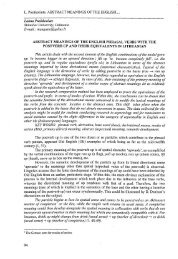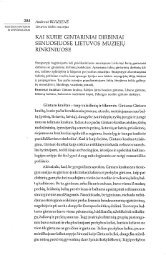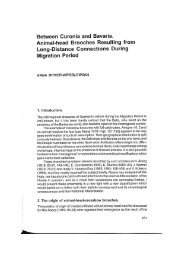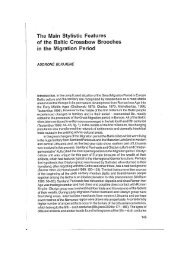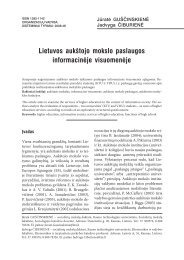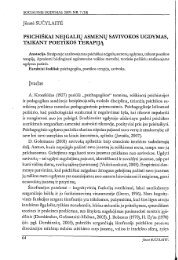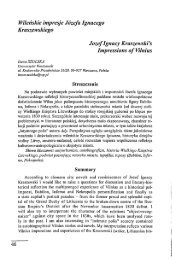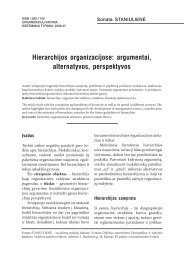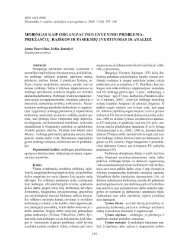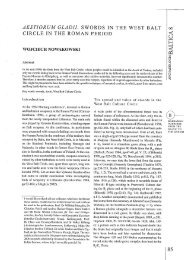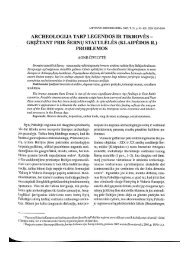ECO-MARKETING AND ECO-LABELLING: DOES IT ENSURE ...
ECO-MARKETING AND ECO-LABELLING: DOES IT ENSURE ...
ECO-MARKETING AND ECO-LABELLING: DOES IT ENSURE ...
Create successful ePaper yourself
Turn your PDF publications into a flip-book with our unique Google optimized e-Paper software.
D.Grundey 167 ISSN 1648-4460<br />
Researching Customer Loyaity in Lithuania<br />
1998 1999 2000 2001 2002 2003<br />
Source: complied by the author.<br />
Figure 3. European Eco-Label (the "Flower") statistics, 1998-2003<br />
It has been caleulated that eurrently in Europe we have the following statistics for the<br />
EU-flower eco-label {Figure 3):<br />
. 260 holders as of September 2005<br />
About 2 500 articles split in 23 product groups<br />
A large number of ISO-type II labels are found in the European market established and<br />
mn by the industry or retailers. These self-classifications are often one-dimensional, covering<br />
only certain aspects of the product, like recycled paper products, phosphate free detergents.<br />
ISO type III labels - Environmental Product Declaration (EPD) - are under development in<br />
Europe. Such quantitafive data will, however, be more relevant in a business-to-business<br />
communicafion.<br />
3.3.2 ISO-type II labels<br />
ISO-type II labels really are a type of adverfising. Main problems concerning such<br />
labels are that the message is often unclear, labels often one deal with just dimension (no<br />
chlorine), they are at best semi-scienfifically based, and they rely on self-classificafion. In the<br />
Nordic countries they tend to conflict with the Marketing Control Acts, prohibiting the use of<br />
phrases like "eco friendly" etc. Type II labels will generally have a problemafic relafion to<br />
questions of tmst, and - related to that - to generally non-existent control regimes.<br />
since tenns lil^c "eco", "biological" and similar<br />
designations have been protected by the EC Eco-<br />
Directive, consumers liave been finding food from<br />
organic fanning everywhere. The big supeniiarket<br />
chains in Germany have introduced product ranges like<br />
Füllhorn (Rewc). Grünes Land (Metro), Naturkind<br />
(Tcngclmann/Kaiscrs), Alnalura (dm), all of whicli<br />
definitely come from organic fanning. Other organic<br />
brands are called "Organic from ecological production",<br />
"HioUio" or "Bio Wcrlkost". Organic products from<br />
health food producers bear a green leaf witli the word<br />
"Bio".<br />
Source: complied by the author.<br />
Cooperation between organic fanning organisations and governmental<br />
institutions has created eco-labels which do not solely stand for organic<br />
fanning, but also confinn that these products come from a particular region or<br />
a particular state of Gcnnany. It's this regional delimitation that constitutes the<br />
specific bonus of these labels, since tlie transportation distances involved are<br />
also subject lo restriction. Examples include (from the Icfi) the Test Seal for<br />
ecologically produced food awarded by the Free State of Saxony, the<br />
registered symbol for ecological fanning in confonnily with the EC Eco-<br />
Dircctivc awarded by Thuringia's Ministry for Agriculture, Nature<br />
Conservation and the Environment, and the test seal for local ecological<br />
products awarded by the Bavarian State Ministry for Nutrition, Agriculture<br />
and Forestry.<br />
Figure 4. Examples of ISO-type II labels (examples from Germany)<br />
Potential environmental advantages of Type Il-labcls arc first that for the least<br />
.sophisticated producers or retailers (Figure 4), a Type 11-labcl might be a starting poiiU for a<br />
positive cliaiigo process, coiiccniraling on doing al least something. Second, for leading<br />
77t-hV.n'OIÜt.-ri70,V.V/,V ;it;,f/A7;.V.V c-liCOSO.Mia, Vol 8, No 1 (16), 2009



